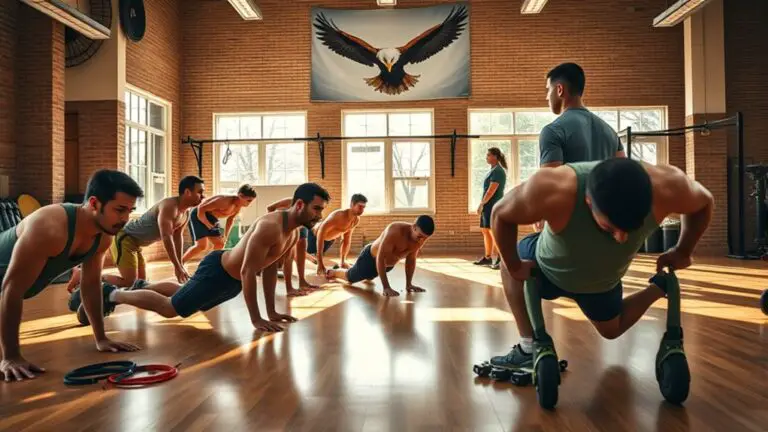The Importance of Goal Setting in Gym Training

Setting goals in gym training is essential for your success. It gives you direction, boosts motivation, and breaks your larger aspirations into manageable steps. Short-term goals provide quick wins, while long-term objectives keep your vision clear. Using SMART criteria guarantees your goals are achievable and time-bound, making them easier to track. Remember to celebrate small victories and adapt your plans as needed to stay engaged. Discover how to enhance your journey and overcome challenges along the way.
Understanding the Role of Goals in Fitness

Setting goals is essential to your success in fitness, providing direction and purpose in your training journey. When you achieve goal clarity, you’ll know exactly what you’re working toward, making your workouts more focused and effective. This clarity helps you break down your larger aspirations into manageable steps, which keeps you motivated and on track.
To enhance your progress, implement motivation strategies that resonate with you. Whether it’s tracking your workouts, celebrating small victories, or surrounding yourself with a supportive community, these techniques can fuel your determination. Remember, the right goals not only push you beyond your limits but also give you a sense of accomplishment as you reach them.
Types of Goals: Short-term vs. Long-term
When it comes to gym training, understanding the difference between short-term and long-term goals is essential. Short-term goals give you quick wins that keep you motivated, while long-term objectives provide a broader vision for your fitness journey. Balancing both types can help you stay on track and make steady progress toward your ultimate fitness aspirations.
Defining Short-term Goals
Short-term goals in gym training act as stepping stones toward your ultimate fitness aspirations. These goals help you focus on personal milestones, making your journey less overwhelming and more manageable. Instead of solely aiming for long-term outcomes, break your targets into smaller, measurable achievements. For instance, aim to increase your squat weight by 5 pounds in a month or commit to exercising three times a week. These specific goals not only boost your motivation but also provide a sense of accomplishment as you progress. When you celebrate these short-term victories, it reinforces your commitment and keeps you on track. Remember, every small win is a crucial part of your overall fitness journey!
Establishing Long-term Objectives
Achieving your fitness goals requires a clear vision of long-term objectives that guide your journey. Establishing these long-term objectives not only fosters personal growth but also guarantees life balance. Here are four key components to evaluate:
- Define Your Long-term Vision: Visualize where you want to be in one, three, or five years.
- Set Milestone Achievements: Break your journey into smaller, manageable targets to celebrate progress.
- Focus on Consistent Progress: Commit to daily habits that align with your long-term goals.
- Adjust as Necessary: Life changes; be flexible and adapt your goals to maintain motivation and balance.
Balancing Both Types
While it’s essential to have long-term goals in mind, balancing them with short-term objectives can greatly enhance your fitness journey. Short-term goals serve as milestones, allowing you to celebrate progress and stay motivated. By focusing on these smaller targets, you can manage your workout intensity effectively, ensuring you’re pushing yourself without risking burnout.
How to Set SMART Goals for Your Training
Setting SMART goals can transform your gym training by providing a clear roadmap to success. By applying the SMART criteria, you can create goals that are specific, measurable, achievable, realistic, and time-bound. Here’s how to set effective goals:
Harness the power of SMART goals to create a clear path to success in your gym training.
- Specific Milestones: Define exactly what you want to achieve, like “I want to squat 200 pounds.”
- Measurable Outcomes: Use numbers to track your progress, such as “I’ll increase my weight by 5 pounds each week.”
- Achievable Targets: Confirm your goals are realistic, so you stay motivated and avoid burnout.
- Time-Bound Deadlines: Set a deadline, like “I’ll reach my goal in three months,” to keep you accountable.
Tracking Progress and Adjusting Goals

To make the most of your gym training journey, it’s essential to track your progress and adjust your goals as needed. Monitoring your progress metrics—like weight lifted, endurance levels, or body measurements—helps you see how far you’ve come. This not only boosts your motivation but also allows you to identify areas needing improvement.
As you advance, don’t hesitate to make goal adjustments. If you’re consistently hitting your targets, it might be time to raise the bar. Setting new challenges keeps your workouts fresh and engaging. Conversely, if you find certain goals too intimidating, it’s okay to scale back. Flexibility in your approach guarantees you stay committed without feeling overwhelmed.
Staying Motivated: The Psychological Benefits of Goal Setting
Setting goals in your gym training isn’t just about numbers; it’s a powerful tool for enhancing your focus and clarity. When you have specific objectives, you boost your confidence and morale, keeping you committed to your fitness journey. Plus, those goals establish accountability, making it easier to stay on track and motivated.
Enhancing Focus and Clarity
While you might think of goal setting as just a way to track your progress, it actually plays an essential role in enhancing your focus and clarity during gym training. When you set specific goals, you sharpen your attention, making each workout session more productive. Here are some effective focus techniques and clarity exercises to contemplate:
- Define Specific Targets: Clearly outline what you want to achieve, like lifting a certain weight.
- Break it Down: Divide your overall goal into smaller, manageable milestones.
- Visualize Success: Spend a few minutes picturing yourself achieving your goals.
- Regularly Review Goals: Keep your targets fresh in your mind to maintain motivation.
These practices not only boost your concentration but also help you stay on course toward your fitness aspirations.
Boosting Confidence and Morale
Confidence and morale can soar when you set and achieve clear goals in your gym training. By establishing specific targets, you create a roadmap for success, which leads to confidence building as you reach each milestone. This sense of accomplishment not only boosts your self-esteem but also enhances your overall motivation.
Here’s a quick overview of how goal setting impacts your confidence and morale:
| Impact | Description |
|---|---|
| Confidence Building | Achieving goals strengthens self-belief. |
| Morale Boosting | Progress motivates continued effort. |
| Focused Mindset | Clear objectives reduce anxiety. |
| Enhanced Resilience | Overcoming challenges builds toughness. |
Establishing Accountability and Commitment
When you establish accountability and commitment in your gym training, you’re laying the groundwork for sustained motivation and progress. Here are some effective commitment strategies to contemplate:
- Find an Accountability Partner: Team up with a friend or trainer who can motivate you and track your progress.
- Set Regular Check-Ins: Schedule weekly or monthly catch-ups to discuss goals and celebrate achievements.
- Create a Workout Log: Document your workouts, noting improvements and setbacks to visualize your journey.
- Share Your Goals Publicly: Announce your targets on social media or in your community to increase your commitment to follow through.
Overcoming Challenges and Staying Committed to Your Goals
Although fitness journeys can be filled with obstacles, staying committed to your goals is essential for long-term success. You’ll face challenges, whether it’s a hectic schedule, fatigue, or plateaus. The key to overcoming these obstacles is maintaining discipline. Set clear, achievable milestones that keep you motivated. When setbacks occur, remind yourself why you started.
Create a supportive environment by surrounding yourself with like-minded individuals who uplift you. Track your progress to celebrate small victories, as these will reinforce your commitment. And don’t forget to be flexible; sometimes, adapting your plan is necessary.
Focus on the end goal but enjoy the journey too. Incorporate variety in your workouts to keep things fresh and exciting. By embracing challenges and maintaining discipline, you’ll not only reach your fitness goals but also develop resilience that transcends the gym. Additionally, regular exercise reduces the risk of chronic diseases, enhancing your overall health. Stay committed; your future self will thank you!
Frequently Asked Questions
How Often Should I Reassess My Fitness Goals?
Did you know that 70% of people who set fitness goals regularly reassess them? You should aim to evaluate your goals every 4 to 6 weeks. This goal frequency allows you to track your progress evaluation effectively and adjust your plans as needed. If you’re not seeing results, it’s time to tweak your strategy. Stay flexible and motivated, and remember, adapting your goals can lead to greater success in your fitness journey!
Can I Set Goals Without a Gym Membership?
Absolutely, you can set goals without a gym membership! Focus on what you can achieve through home workouts or outdoor activities. Whether it’s mastering a yoga routine, completing a certain number of push-ups, or running a specific distance, your goals can be just as effective. Make them specific and measurable, and don’t forget to celebrate small victories along the way. With creativity and determination, you can reach your fitness aspirations anywhere!
What if I Don’T Achieve My Goals?
If you don’t achieve your goals, it’s time for some goal reflection. Instead of seeing it as a failure, consider it an opportunity for a mindset shift. Ask yourself what obstacles you faced and what you can learn from the experience. Adjust your goals if necessary, and remember that progress isn’t always linear. Stay motivated, and focus on the journey. You’ve got the power to redefine your path and keep pushing forward!
How Do I Involve a Workout Partner in Goal Setting?
To involve a workout partner in goal setting, start by discussing your individual goals openly. Share your aspirations and ask about theirs. Establish mutual goal accountability by checking in regularly on progress. You can motivate each other by celebrating small wins and pushing each other during tough workouts. Consider setting joint milestones to strengthen your partnership. Remember, having a supportive partner can enhance your motivation and keep you both on track toward success.
Are There Specific Goals for Different Fitness Levels?
Did you know that nearly 80% of people who set specific fitness goals are more likely to succeed? If you’re a beginner, focus on achievable goals like completing a certain number of workouts per week or mastering basic exercises. For those at an advanced level, consider targets like increasing your lifting weight by 10% or running a specific distance faster. Tailoring your goals to your fitness level keeps you motivated and guarantees continuous progress!





